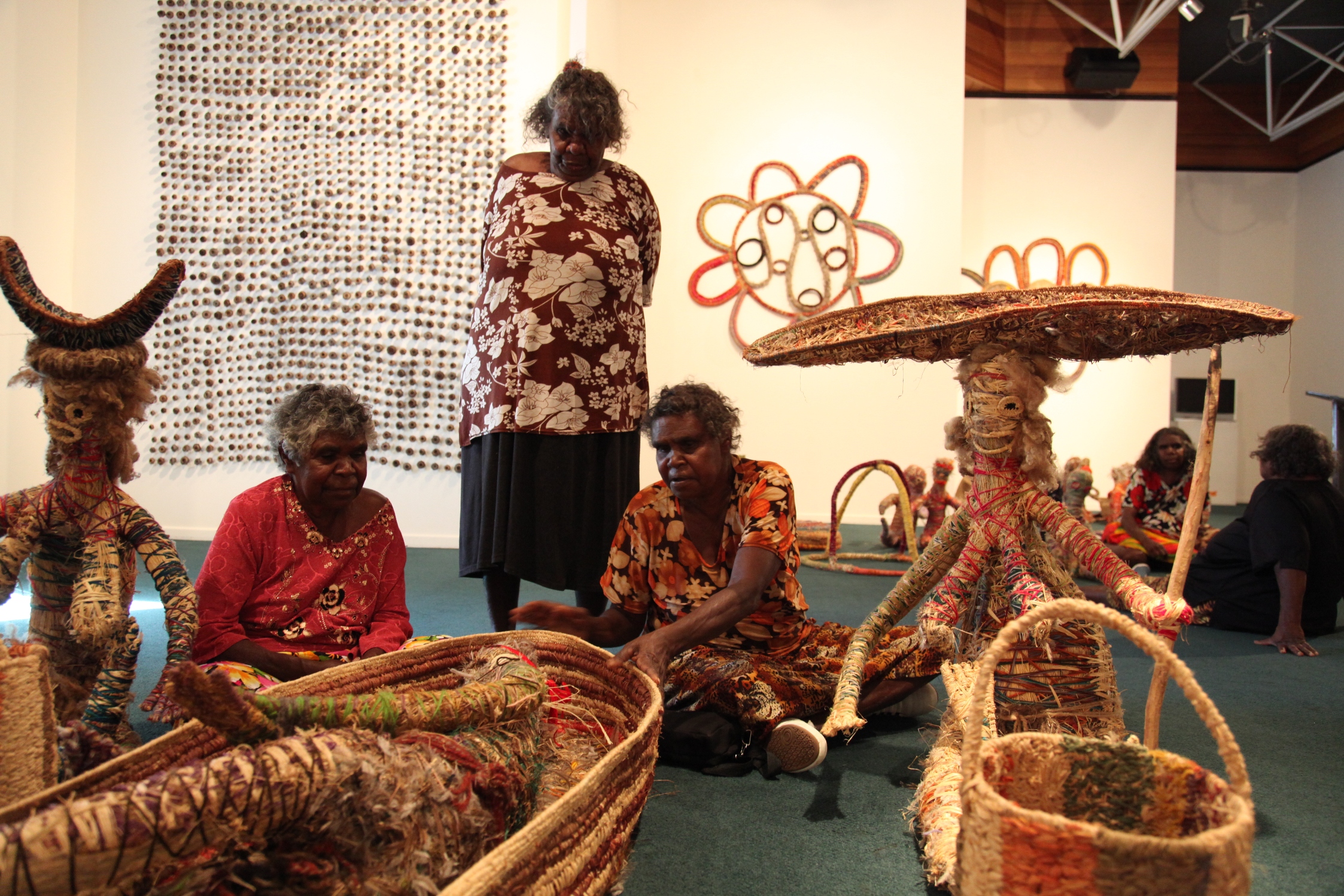PRIZE REVIEW: Burnie Print Prize 2025

This month, Arts Law has reviewed the terms and conditions of the ‘Burnie Print Prize 2025’ (the Prize) organised by the Burnie Regional Art Gallery (the Organiser). Read the terms and conditions of this competition here.
This month, Arts Law has reviewed the terms and conditions of the ‘Burnie Print Prize 2025’ (the Prize) organised by the Burnie Regional Art Gallery (the Organiser). Read the terms and conditions of this competition here.
The closing date for this competition is 5pm, 3 November 2024.
What is the rating?
Arts Law has awarded the competition 4 stars out of 5. Read on to find out more detail.

How did Arts Law help?
Arts Law reached out to the Organiser to make the competition’s conditions of entry more friendly to the artists who are entering (the Entrants). We are delighted that they took on board our suggestions and updated their terms from what was originally published. This process helped to lift the terms from an overall rating of 2.5 or 3 stars to the current rating of 4 stars out of 5.
What is the Burnie Print Prize about?
The Burnie Print Prize celebrates the best of contemporary printmaking in Australia. Since 2007, the Prize has supported artists working with the print medium to foster innovation, celebrate craftsmanship and promote the art form. Artists living and working in Australia are encouraged to enter a print or artist’s book created using any printing process.
How artist-friendly is this competition?
The competition’s terms are very artist-friendly. Arts Law has awarded a 4-star rating to reflect the improvements that the Organiser made to protecting artists’ rights.
Copyright
The terms state that: ‘Burnie Regional Art Gallery recognises and respects the intellectual property, moral, and Indigenous Culture & Intellectual Property rights of the artist.’
We are pleased to see that the Organiser has explicitly stated in writing that they respect these rights. It would be good for the Organiser to use specific words to the effect that Entrants are acknowledged as copyright owners of their works and will retain such copyright in their works, but this appears to be the intended purpose of the terms.
With respect to licensing, the terms provide that shortlisted Entrants agree to grant the Organiser a non-commercial, non-exclusive licence for specific promotional purposes for a period of no more than 3 years. The winner consents to granting the Organiser a non-commercial, non-exclusive licence for specific promotional purposes in perpetuity. It is great to see that the Organiser took on board our feedback to set out these licensing terms clearly, and that they are fair to artists.
Moral Rights
We are pleased to see that the Organiser actioned our feedback to insert a term about moral rights, quoted above. This positive inclusion could be improved by further detail that the Organiser will:
- credit the artist when their work is used (the right of attribution); and
- refrain from treating the work in a way that hurts the artist’s reputation (the right of integrity).
Entrants should be aware that the current moral rights term:
- provides no further protection than is already afforded under the Copyright Act;
- as the shortlisted Entrants and winner grant a licence for the purpose of promoting the competition, they may be deemed to have consented to a range of acts by the Organiser that may otherwise constitute an infringement of their moral rights; and
- the Organiser may, in any event, rely on the defence of reasonableness relating to any treatment of an Entrant’s artwork that would otherwise be deemed to constitute derogatory treatment. Entrants can read Arts Law’s Information Sheet on Moral Rights for more information on the scope of this defence.
ICIP
It is great that the Organiser applied our feedback to include a reference to ICIP in the Prize terms.
Ideally, we would like this term to be expanded in a way that requires an artist to inform the Organiser if there is any ICIP in the artwork. If so, any display of the artwork or of an image of the artwork would be accompanied by an ICIP notice. An ICIP notice would acknowledge the inclusion of ICIP, acknowledge the traditional custodians, and state that dealing with any part of the work for any purpose that has not been authorised by the traditional custodians may be a serious breach of the customary laws of that community. Contact details for enquiries regarding permitted uses of the work can also be included in the notice. Entrants can read Arts Law’s Information Sheet on Indigenous Cultural and Intellectual Property for further details.
Transport, Risk and Insurance
Originally, the terms stated that the Organiser would only insure works held onsite for the duration of the exhibition. In discussion with the Organiser, they clarified that they intend to insure the works for the entire time they are held onsite, including when in storage outside the exhibition period. It is great to see the updated terms set out this position more clearly.
Shortlisted Entrants should note that works may be condition inspected up to 2 weeks following their arrival, and that receipt of work does not imply good condition.
Furthermore, shortlisted Entrants (not the Organiser) must bear the cost of insuring their works during transit. Entrants must also bear all costs of delivery and return of their works. The Organiser will package returns (at the Entrants’ cost), otherwise Entrants can organise collection by a courier at their own cost. The Organiser advised Arts Law that pending funding availability in the future, they will explore the possibility of subsidised or shared freighting arrangements for shortlisted entries, but this is not available for the 2025 Prize. We encourage the Organisers to consider sharing some of these costs with Entrants, in line with the National Association for the Visual Arts’ (NAVA’s) Code of Conduct.
It is good to see that the current terms give artists ample time to organise delivery and collection/return.
Prizes
There are 3 prizes available:
- Burnie Print Prize: a $17,000 acquisitive prize, where the work is purchased to form part of the Organiser’s permanent collection;
- Emerging Artist Award: a $5,000 non-acquisitive prize; and
- Public Vote Award: a $1,000 non-acquisitive prize.
Other aspects of the prize
Eligibility
The Prize is open to all artists living and working in Australia.
Entry
There is a $40 entry fee for this Prize.
Only print medium works are eligible. The terms state:
‘This includes techniques such as relief printing, intaglio printing, planographic printing, and stencil printing. Digital reproductions of print artworks are also eligible for submission, provided the original artwork was created using traditional printmaking methods.
Artworks created using other mediums such as painting, drawing, sculpture, digital art (excluding digital reproductions of print artworks), photography, and mixed media are not eligible for entry.’
The terms do not state whether AI-generated designs will be accepted, though there is direct acknowledgement that digital reproductions of print artworks are eligible so long as traditional printmaking methods were used to create the original artwork..
Entrants are able to submit 1 work only, but it may be composed of several elements. The work should have been completed within 2 years prior to November 2024. Entrants must submit:
- a biography (maximum 500 words);
- an artists statement about the submitted work (maximum 250 words, for inclusion on labels); and
- up to 3 or 5 images (1 showing the complete work, and up to 2 images showing details of that work or up to 4 images showing details if submitting an artist book).
Entrants must affirm that they are the original creators of their submission and that they hold all necessary rights and permissions to enter their artwork into the Prize. Entrants will be immediately disqualified if they infringe third-party rights.
Selection Process
The judging panel will be made up of Marnie Karmelita, Michael Edwards, Ray Arnold and Melissa Smith. Details about the judging panel are available on the Organiser’s website. The judges will assess the submitted digital images to select a shortlist, and Entrants will be notified of the outcome of this shortlist by 29 November 2024 (about 4 weeks after the submission deadline).
Once these shortlisted artworks are installed in the exhibition, the judging panel will select the Prize winners. The winners will be announced at the opening of the Prize exhibition on 14 March 2025. The terms do not specify when the Public Vote Award will be announced, but Arts Law presumes this will be at some point during, or at the conclusion of, the exhibition.
All Entrants are invited to attend the opening of the exhibition in-person or virtually. It is good to see that winners are not required to attend in-person in order to accept their Prize at the opening, as this might otherwise have been a financial barrier to some artists.
Sale of Artworks
Shortlisted Entrants should be aware that all of the works entered into the exhibition must be eligible for acquisition.
The Organiser is a public gallery so they cannot offer the shortlisted works for sale to the public. However, it is great that the Organiser will pass on any sale enquiries to the artist or their representative, and that the Organiser will not charge any commission for doing so.
What could the Organiser do better in future?
In summary, the Organiser could make the terms of the Burnie Print Prize fairer to Entrants by:
- providing more detail about the intellectual property rights protections; and
- sharing the freighting and transit insurance costs with shortlisted Entrants.
These changes would raise the rating to a 4.5 or 5 stars out of 5 stars.
About Arts Law’s prize reviews
Arts Law regularly reviews the terms and conditions of competitions and rates them out of five stars. Our review looks broadly at the terms and conditions of a competition. In particular we look closely at how a competition deals with an entrant’s copyright and moral rights,and consider this in light of the prize. Entrants should always consider the possible profile-raising which may result from being a finalist or winner.
By accepting the terms and conditions of a competition, entrants should be aware that they may be entering a legally binding contract.
For more information, see our free information sheet on competition conditions. Artists are welcome to contact Arts Law for legal advice on the terms of a competition. We also invite competition organisers to contact Arts Law for best practice assistance to make their terms and conditions fairer for artists.
Further Information
Please email us at [email protected] to tell us about any competitions or prizes you think we should check.
See more about Arts Law’s campaign to improve competition terms and conditions in the Prizes and Competitions section.




